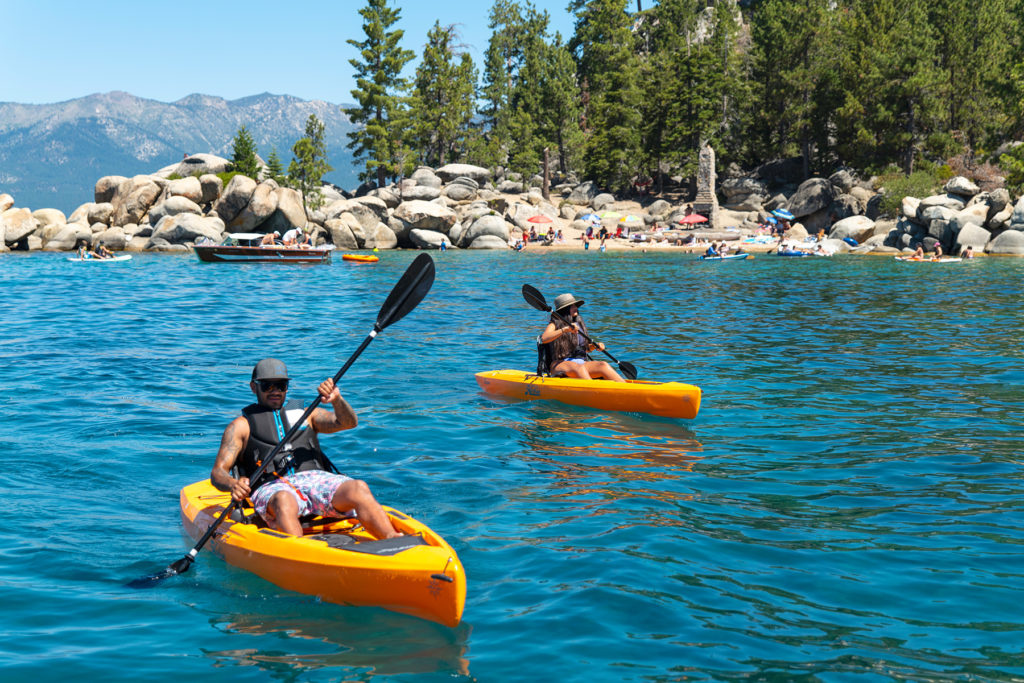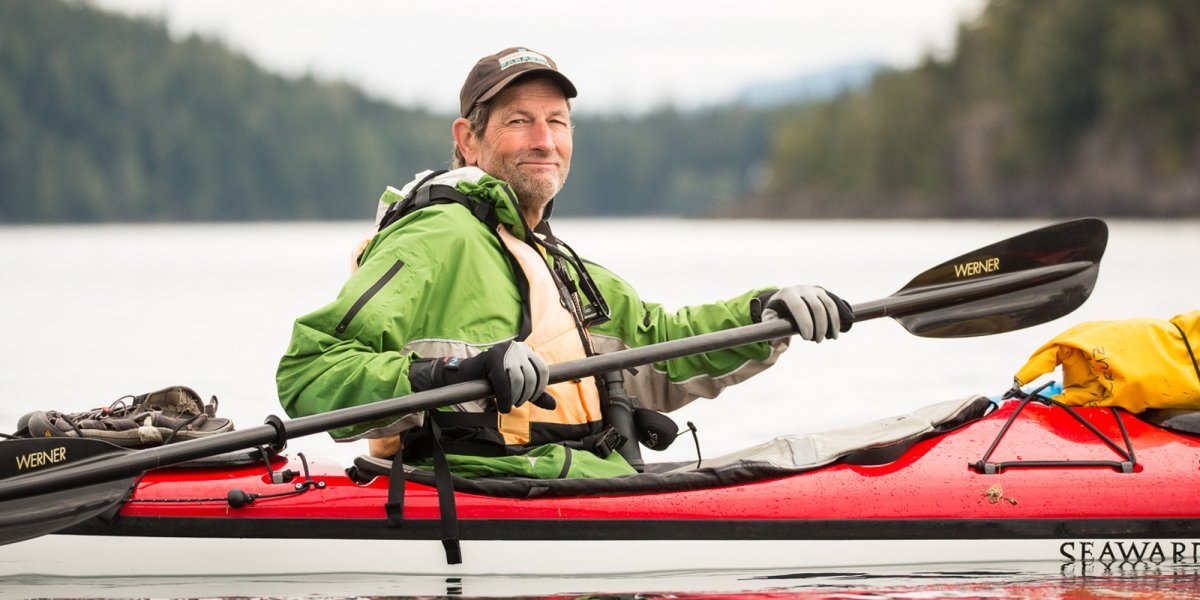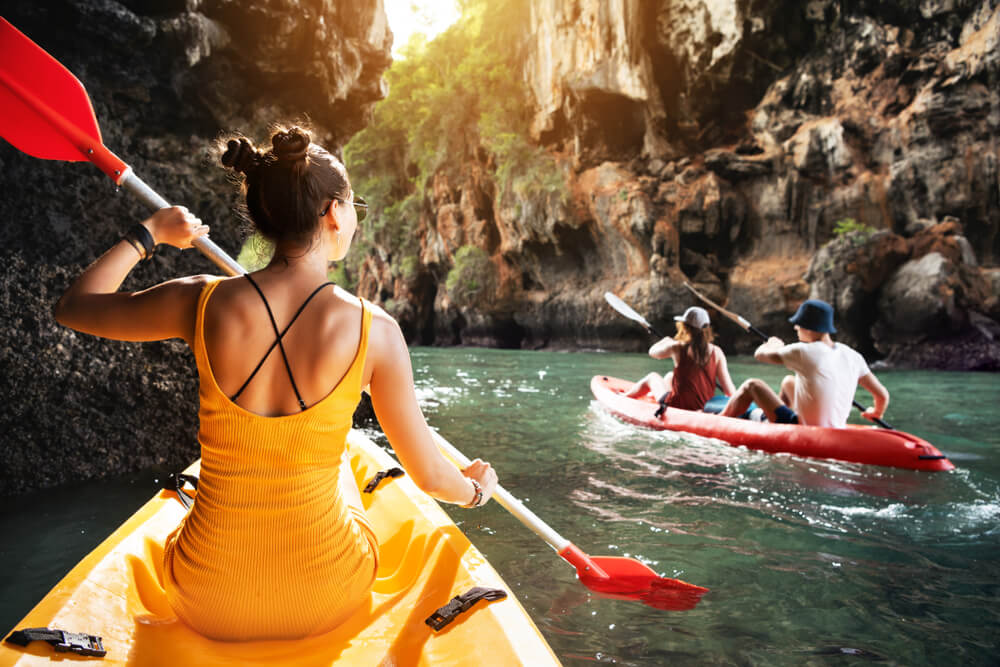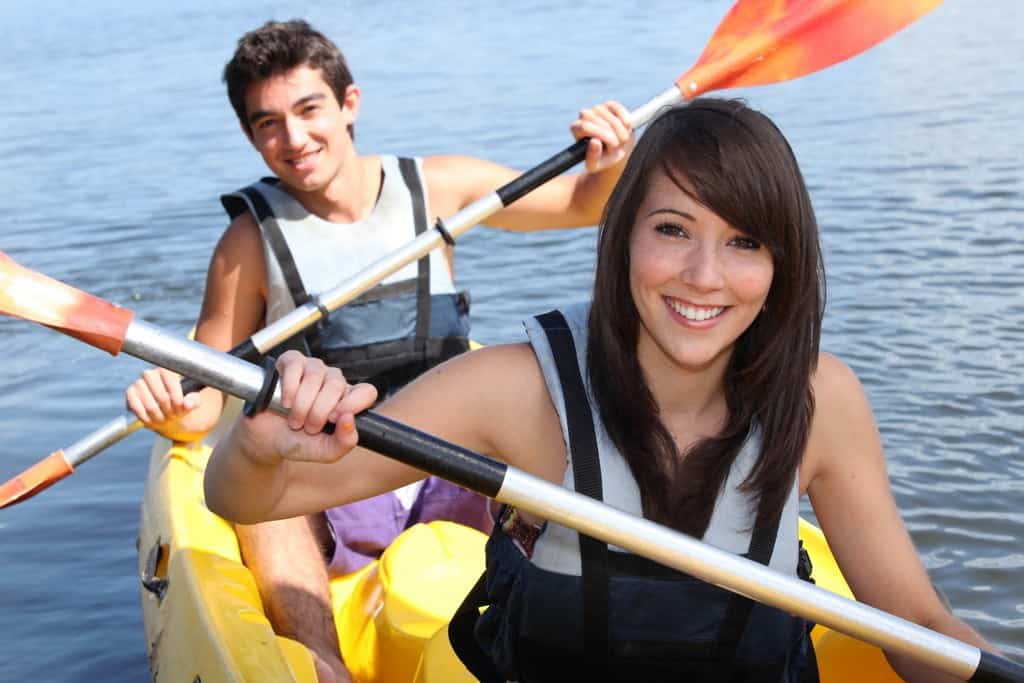Introduction

Embarking on a kayaking adventure combines the thrill of exploration with the serenity of being on the water. However, to ensure a comfortable and safe experience, it’s crucial to know what to wear for kayaking.
The right attire can make all the difference, whether you’re gliding through calm waters or navigating choppy waves. From the importance of a personal flotation device (PFD) to the necessity of proper footwear, this guide will provide you with comprehensive insights into kayaking apparel that caters to various weather and water conditions.
When selecting your kayaking wardrobe, it’s essential to dress for the water temperature, not just the air temperature. This means considering layers that can handle immersion and protect against hypothermia.
With 509 paddling-related drownings reported in 2016, and only a fraction wearing a PFD, the significance of safety gear becomes evident (Southern Tide).
As we delve into the specifics of kayaking attire, remember that the right clothing is not just about comfort; it’s a key component of your safety on the water.
Choosing the right clothing for kayaking

Consider the weather and water conditions
When planning your kayaking outfit, assessing the weather and water conditions is paramount. If you’re heading out in the summer, lightweight, quick-drying fabrics are ideal, providing protection from the sun while keeping you cool.
Conversely, cooler climates demand layers that retain warmth even when wet. Always anticipate the possibility of capsizing; hence, attire that offers thermal protection in the water is a must.
The water’s temperature often differs from the air’s, and dressing for the chillier of the two ensures you’re prepared for an unexpected plunge (Log Kayak Rack).
Moreover, the type of kayaking you intend to do influences your clothing choices. Recreational kayakers can opt for comfort and flexibility, while those engaging in more vigorous forms such as whitewater kayaking should consider specialized gear like wetsuits or drysuits.
Regardless of the activity, avoid cotton and select materials like polyester or nylon that repel water and facilitate a quick dry-off. This approach not only enhances comfort but also plays a critical role in maintaining your body temperature and overall safety on the water (DiveIn).
Protective clothing and gear
Equipping yourself with protective clothing and gear is a cornerstone of kayaking safety and comfort. A rashguard, preferably with a UPF rating, serves as an excellent base layer, offering quick-drying properties and essential protection from UV radiation.
For the outer layers, rugged and durable fabrics that withstand the elements without compromising flexibility are recommended. These include waterproof jackets or gilets, and drysuits that ensure you stay dry and warm, even when the water splashes over.
It’s also wise to steer clear of garments with zippers or metal parts, as these can corrode in saltwater environments, diminishing the longevity and safety of your kayaking apparel (DiveIn).
Additionally, a well-fitted personal flotation device (PFD) is non-negotiable and should be worn at all times on the water. Not only does it provide buoyancy in the event of capsizing, but it also adds an extra layer of warmth.
Select a PFD that accommodates your kayaking attire comfortably and allows for full range of motion, ensuring that safety does not come at the expense of your paddling experience.
Remember, the right protective gear is not just about compliance with safety standards; it’s about empowering your kayaking journey with confidence and peace of mind (GILI Sports).
Footwear for kayaking
Water shoes or sandals
Choosing the right footwear for kayaking is crucial for both safety and comfort. Water shoes or sandals with a closed-toe design are ideal, as they protect your feet from sharp objects and provide stability on slippery surfaces.
These shoes are specifically engineered to transition seamlessly between water and land, offering additional protection when climbing onto wet rocks or navigating through shallow areas.
Unlike regular sneakers, which can become heavy and uncomfortable when wet, water shoes are designed to be lightweight and quick-drying, ensuring your focus remains on paddling rather than discomfort (Southern Tide).
When selecting kayaking footwear, it’s also important to avoid flip-flops or going barefoot, as these options do not provide the necessary support or protection.
Hiking sandals with a back strap are a good alternative, offering quick drying times and less irritation for your feet. They also stay on securely, even if you capsize, unlike flip-flops which can easily come off.
For those kayaking in colder conditions, neoprene booties are a better choice, as they provide warmth and are designed to withstand extended periods in colder waters, allowing you to enjoy your kayaking adventure for longer durations (GILI Sports).
Avoid flip-flops or bare feet
While flip-flops might seem convenient for quick transitions between land and water, they are a poor choice for kayaking. They offer minimal protection against underwater hazards and lack the necessary grip on wet surfaces, increasing the risk of slips and injuries.
Moreover, in the event of capsizing, flip-flops are prone to falling off, leaving your feet vulnerable and potentially leading to the loss of your footwear.
Similarly, kayaking barefoot is not advisable, as it exposes your feet to sunburn, cuts, and abrasions, detracting from the overall safety and enjoyment of your paddling experience (Log Kayak Rack).
Therefore, it’s essential to invest in proper kayaking footwear that will safeguard your feet and enhance your performance on the water.
Whether you opt for specialized kayak shoes or robust water sandals, ensure they fit snugly, provide ample protection, and are made from materials that repel water effectively.
This attention to detail in your choice of footwear will pay dividends in comfort and protection, allowing you to focus on the rhythm of your paddles and the beauty of the surroundings (DiveIn).
Layering for kayaking

Moisture-wicking base layer
Embarking on a kayaking journey, the foundation of your attire should be a moisture-wicking base layer. This essential garment, often made from synthetic fabrics like polyester or specialized blends, is designed to draw sweat away from the skin, keeping you dry and comfortable as you paddle.
A high-quality base layer, such as a quick-dry top or a lycra piece, is crucial because it helps regulate your body temperature by preventing the accumulation of moisture, which can lead to chills, especially in cooler weather.
For those seeking an exceptional option, consider garments with quick-dry technology and performance fabrics, like a women’s cable knit athletic quarter zip pullover, which ensures warmth without sacrificing breathability (Southern Tide).
Moreover, the right base layer serves as the first line of defense in a layered clothing strategy, a technique vital for adapting to changing conditions on the water. It’s important to select a non-cotton, snug-fitting base layer that won’t bunch up or restrict movement as you navigate through the waters.
This layer works in tandem with additional insulating and waterproof layers to provide a comprehensive protective system, allowing you to enjoy kayaking regardless of the season or temperature (GILI Sports).
Insulating layer
Once you’ve established a solid moisture-wicking base, the next step in preparing for kayaking is adding an insulating layer.
This layer is pivotal for retaining body heat and providing comfort in cooler conditions. Options for this middle layer range from fleece jackets to specialized kayaking vests, which offer both warmth and flexibility.
For instance, a hooded Anorak jacket can serve as an excellent insulating piece, featuring water-repellent properties that keep you warm even when the temperature drops.
The key is to choose materials that continue to insulate even when wet, such as synthetic fibers or wool, ensuring that you stay toasty throughout your paddling adventure (Southern Tide).
It’s essential to consider the fit and layering compatibility of your insulating garments. They should be snug enough to trap heat but not so tight as to restrict movement or prevent proper layering with your base and outer layers.
Remember, the insulating layer is a crucial component in your kayaking attire, working in concert with other layers to maintain your core temperature and enhance your overall experience on the water, regardless of the weather conditions you encounter (DiveIn).
Waterproof outer layer
The final touch in your kayaking apparel is the waterproof outer layer, which shields you from wind, rain, and splashes. A high-quality drysuit or waterproof jacket is indispensable, especially when facing harsher elements or colder climates.
These outer layers are designed with gaskets and cuffs to prevent water ingress at vulnerable points such as the neck and wrists.
Look for jackets that are 100% waterproof yet flexible, ensuring full mobility for paddling without constriction. The best outerwear will not only keep you dry but also complement the insulating properties of your mid-layers, creating an effective barrier against the cold (DiveIn).
When selecting a waterproof layer, consider the breathability of the material to prevent overheating and ensure comfort during prolonged use.
Dry suits, in particular, offer a loose fit that allows for multiple layers underneath, adapting to various temperatures and personal preferences. For those who kayak in milder conditions or prefer less constriction, a semi-dry suit might be the perfect compromise, providing adequate protection without the tight seals around the neck and wrists.
No matter the choice, a reliable waterproof layer is a kayaker’s best defense against the elements, ensuring a pleasant and safe experience on the water (GILI Sports).
Accessories for kayaking

Sunglasses with strap
As you gear up with the appropriate layers for kayaking, don’t overlook the importance of protecting your eyes. Polarized sunglasses are a must-have accessory to combat the intense glare reflecting off the water, which can impair vision and lead to eye strain.
To ensure these essential items don’t become a casualty of the depths, secure them with a reliable sunglass strap. This simple addition can save you from the frustration of watching your favorite shades disappear beneath the waves, a preventable mishap that’s all too common among paddlers (Southern Tide).
Moreover, when choosing sunglasses for kayaking, opt for a pair with UV protection to shield your eyes from harmful rays. A retainer strap not only prevents loss but also ensures your sunglasses remain readily accessible, allowing you to focus on the adventure at hand without distraction.
With the right pair of sunglasses secured, you can confidently navigate through sunny conditions, knowing your vision is safeguarded throughout your journey (Log Kayak Rack).
Sunscreen and hat
Equally crucial to your kayaking ensemble is the application of sunscreen and the selection of a suitable hat. Even on overcast days, UV radiation can penetrate cloud cover, making sunscreen an indispensable ally in protecting your skin.
Opt for a high SPF, water-resistant sunscreen to maintain effective coverage throughout your paddling excursion. Complementing this, a wide-brimmed hat with a chin strap is ideal for shielding your face and head from direct sunlight, reducing the risk of sunburn and heatstroke.
The chin strap ensures your hat remains in place, even in the event of gusty winds or an unexpected dip in the water (DiveIn).
For those kayaking in colder climates, a beanie can provide essential warmth, while the hood of a waterproof jacket offers an additional layer of protection against rain and spray.
Remember, the goal is to stay comfortable and safe from the sun’s harmful effects, so investing in UPF-rated clothing can further enhance your defense against UV rays.
By adequately preparing with sunscreen and the right hat, you can enjoy your kayaking adventure with peace of mind, knowing you’re well-protected from the elements (Southern Tide).
Personal flotation device (PFD)
When it comes to safety on the water, a personal flotation device (PFD) is non-negotiable. Regardless of the weather or your swimming abilities, wearing a PFD is a fundamental rule in kayaking. It’s not just about compliance with safety regulations; it’s about ensuring your well-being.
A PFD should be worn at all times, fastened before you set off on your aquatic adventure and only removed once you’re safely back on land. Choose a PFD that fits snugly without restricting movement, and make sure it’s appropriate for your weight and the type of kayaking you’ll be doing.
With a staggering 509 paddling-related drownings reported in 2016, and only a small fraction wearing flotation devices, the importance of a PFD cannot be overstated (GILI Sports).
Moreover, the right PFD can offer more than just buoyancy; it can provide an additional layer of warmth and serve as a platform for attaching essential gear. Look for PFDs with pockets and attachment points for items like whistles or strobe lights.
Remember, a PFD’s effectiveness is only as good as its fit and condition, so regularly inspect it for wear and tear. By prioritizing the selection of a high-quality PFD, you’re taking a crucial step towards a safer and more enjoyable kayaking experience (DiveIn).
Conclusion

As we’ve explored, dressing appropriately for kayaking is about balancing comfort, functionality, and safety. From the moisture-wicking base layers to the insulating and waterproof outerwear, each piece of clothing plays a pivotal role in ensuring a pleasant kayaking experience. Footwear, too, must be chosen with care, prioritizing grip and protection.
Accessories like sunglasses, hats, and sunscreen are not mere afterthoughts but essential components that shield you from the elements. And above all, the personal flotation device stands as the guardian of your safety, a non-negotiable item that should be worn at all times on the water.
Whether you’re navigating the serene waters of a lake or braving the choppy currents of a river, remember that the right attire can make all the difference. By preparing for the conditions, layering wisely, and never compromising on safety gear, you can focus on the joys of paddling and the beauty of the great outdoors.
So, gear up with confidence, respect the power of nature, and embark on your kayaking adventures with the assurance that you are well-equipped for whatever comes your way.
Sources:
- https://www.divein.com/kayaking/what-to-wear-kayaking/
- https://www.gilisports.com/blogs/kayaking/what-to-wear-kayaking-for-men-and-women
- https://www.logkayakrack.com/what-should-i-wear-kayaking-in-the-summer/
- https://southerntide.com/blogs/the-southern-edit/what-to-wear-kayaking
FAQ
-
What should a beginner wear when kayaking?
Waterproof jacket: go for the most waterproof jacket you have. You want one that keeps the underlayers dry. Leggings and shorts: if the weather is cold, opt for polyester leggings and some waterproof shorts. If it is warm, bring the leggings along just in case.
-
Do you wear a bathing suit to kayak?
If you are kayaking in a cold lake or river, you will wear a swimsuit to stay warm during cold weather. However, if you are kayaking in a warm body of water, you may be able to get away with wearing shorts and a T-shirt.
-
What do you wear to a kayak in the summer?
You need to dress for the temperature of the water, not the air, and dress in clothing that can get wet and you can swim in if needed. If you are kayaking in the summer, protection from the sun will also be important. That may mean slathering on the SPF or sporting a long-sleeved rash guard and hat.

